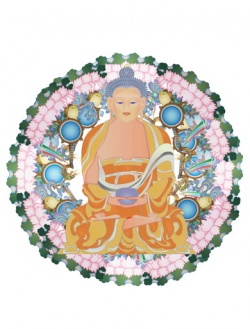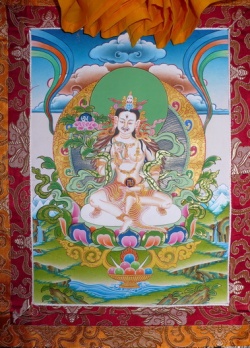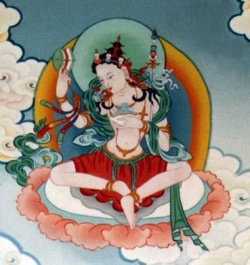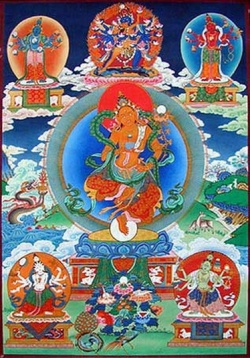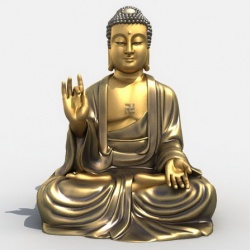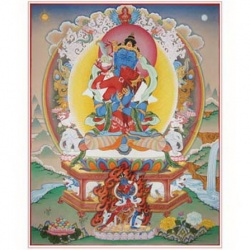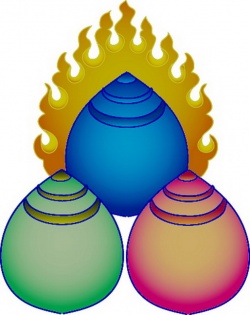Sunyata: The Beautiful Emptiness.
The mind creates the illusion of a ‘subjective’ (inner) world and an ‘objective’ (outer) world. Idealists tend to deny the validity of the ‘objective’, in favour of the ‘subjective’, whilst materialists deny the validity of the ‘subjective’ and emphasis the (exclusive) reality of the ‘objective’. Each position favours one part of the mind and excludes the other part as an illusion. The proponents of these philosophic positions live in a partial world mistaken as a totality of being. Although the philosophy of the Buddhist school of Yogacara can be considered ‘idealist’, in reality this categorisation can not apply, as the Yogacarin philosophy does not acknowledge the validity of the universe being divided into a distinct (and separate) inner world of psychic events, juxtaposed with a separate (material) outer world of physical stuff. – all is ‘mind’, and the mind is essentially ‘empty’ (sunya) of any entity that might be considered ‘permanent’ in any way.
An expedient mind – i.e. personal ego and limited intellect – arises and passes away every single second – and to the unenlightened appears unchanging and eternal. The expedient mind does not arise in a vacuum, but due to karmic fruits manifests spontaneously with the simultaneous arising of the various attributes (dharmas) that comprise the apparent ‘outer’ world. The physical world, the expedient (deluded) mind, and the physical body arise together due to conditioned causes. The outer world arises and passes away as the expedient mind arises and passes away – no difference can be found. The material philosopher does not see that the outer world is a manifestation of the mind, and that the outer world is not static in reality, but only appears to be so when developed insight (prajna) is lacking.
The inner and outer worlds are two-halves of a conditioning ‘whole’ that is only realised with the attainment of full enlightenment. Until that time the expedient intellect creates numerous (limited) philosophical perspectives about existence and the physical universe. These systems, by their very natures are limited by the boundaries that define their respective – usually mutually excluding – theories. As these theories are incomplete, this sets the stage for each to compete with the others by extolling self-defined ‘truths’ and rejecting any other ‘truth’ that does not agree, or is not in accordance. This kind of thinking is presented in the earlier and later Buddhist teachings as the theories of the unenlightened philosophers. Yogacara sees all as ‘mind’, with mind being ultimately ‘empty’ (sunya) of any permanent, underlying entity – the Mādhyamaka (or ‘Sunyavada’) school agrees with its Mahayana rival that all is indeed ‘empty’ (sunya), but in so doing stresses that even the mind that sees this is equally ‘empty’. Despite differences in interpretation it is agreed that ‘emptiness’ (sunyata) is the true essence of reality.
The mind, the physical world and its perception, conception, and consciousness, etc, is one entire and complete conditioning event that is mistakenly perceived as a separate inner mind receiving information from a distinct external world, mediated by the physical body that is occupied during a life time of existence. Implicit within this mistaken view is that a physical, material world ‘pre-exists’ an individual life time, and continues to exist after the physical demise of the individual – as if independent of the mind that creates and perceives it. However, as even this mind is ultimately non-existent, there can not be a distinct mind sat in opposition to a material world, and therefore the Buddhist view of ‘sunyata’ (emptiness) as the true nature of reality can not truly be described as ‘idealism’, even though it ascribes a unique philosophical function to the what is described as the ‘mind’ (citta) itself. Mind is an agency through which the reality of ‘non-mind’ is realised.
The world as it appears to exist is merely the product of a karmic fruit (vipaka) consensus whereby the illusion of individual exist within a more or less permanent outer world, is created a priori through the common deluded state of humanity, which predicates existence as being of a greedy, hateful and deluded nature. In other words the tyranny of physical matter being externally real is exactly how the base human delusion works. Humanity, in this limited manifestation appears hemmed in by a physical world that never feels or thinks – it just dominates through its unquestioned presence. There appears, within the delusion a pre-existing history of the world within which the individual is born. There also appears to be a post-existing world, as it is clear that others have lived and died, and the physical world is seen to have continued.
This is to be expected and a certain logic can be premised upon the observation of this state – but enlightenment can not be through it, as it stands. The mind, whether ultimately existent or not, remains the Buddhist agency for the application and focus of transformational training – it is the mind that ‘sees’ that must be changed so that it views existence as it actually is, rather than how the limited mind and the ordinary senses interpret it to be. The mind is transformed beyond any dualistic notions and can not be assumed to be pure ‘idealism’ as a consequence.
What is clear is that the mind and the world are not as they appear to be. This disparity between how things appear to be and how things actually are is the basis for suffering as defined through Buddhist philosophy. The illusion of ‘separation’ between subject and object is (created) and fuelled by greed, hatred and delusion. Emptiness, as a concept is as central to early Buddhist philosophy as it is to the later, developed Buddhist thinking, although it is within the latter that we see its full development. In Pali it is written as ‘sunna’ (or ‘empty’), or ‘sunnata’ (or ‘emptiness’). In the early suttas the Buddha often talks of the necessity for a monk to find an isolated spot so as to practice meditation. This can be a remote place far from settled communities. It can be at a root of tree, with legs crossed and back straight, with the mind’s attention fixed toward the front (literally in front of the chest).
These appropriate places are termed ‘sunnagara’ – or an ‘empty places’, but this need not be in the wilderness as sometimes the term ‘sunnageha’ to signify an empty building or room. These are not the only places, as caves, cemeteries, grottos, hill, mountains and general open spaces are considered remote and lonely enough to cultivate mindfulness. Furthermore, the Buddha teaches that those who meditate in empty spaces create the inner conditions for the development of the realisation ‘attasunnato’, or ‘emptiness of self’. The presence of physical and isolatory space around the practitioner’s body is eventually mirrored by the realisation of inner space during the practice of effective meditation. All states that arise in the mind during meditation are conditioned and ‘empty’ of any permanency. These states must be abandoned – that is rendered ‘empty’ through insight – so that development into the unconditioned state (of nirvana) can be eventually achieved.
This ‘sunnata-vihara’, (or ‘abode of emptiness’) is considered a very worthy state as it is free of greed, hatred and delusion. This state of emptiness, although acquired in isolated meditation must be maintained even if the practitioner wonders into built-up areas in seek of alms. That is to say that once the outer remote conditions (conducive to effective meditation) have fulfilled their function, the inner state of ‘emptiness’ is fully manifest, becoming stable and constant. The practitioner is able to retain this empty state regardless of whether outer circumstance is peaceful or disruptive. It is a level of development that is beyond the pull of the material world. The early Buddhist suttas teach that the world is ‘empty’ (sunna-loka), but this must be qualified. The world is empty of ‘self’ and anything pertaining to a ‘permanent self’ it is not considered ‘empty’ in and of itself.
The world conditioned (i.e. created) by greed, hatred and delusion, and perpetuated by a sense of a permanent self, is realised to be ‘empty’ of these things, and as a consequence of this realisation, the practitioner is able to abandon attachment to it – therefore it is said the world is truly ‘empty’ of anything that would make it attractive to the senses and inspire desire. Early Buddhism views all physical things (dharmas) as impermanent, continuously changing, and free of any real substance and separate self. Although the realised mind is ‘empty’ of greed, hatred and delusion, as well as a permanent self, the stuff constituting the outer world is not viewed as being part of this ‘emptiness’ of mind. In the enlightened state the ‘empty’ mind stands in (a non-competitive) opposition to a continuously changing physical world – a world that does not share in the mind’s state of emptiness. The mind is free from attachment to the world and this is considered philosophically adequate as a means of explanation for the enlightened state as conveyed within early Buddhism.
Of course, even with is early conception, an enlightened being could be described as abiding in emptiness, and to have thoroughly penetrated (through insight) to the empty nature of the mind and of matter. The physical world is a creation of karmic fruit (vipaka), and as such is transitory. The force of willed (cetana) karma creates the four elements (earth, fire, water, and air) and pulls them into a world of appearance that is suitable for the manifestation of the karmic fruits. The physical world in general, and the circumstance of a particular life, are both the result of personal karma created through greed, hatred and delusion, and the belief in a false, permanent self. Early Buddhism views this karmic world as being insubstantial, but otherwise real in its momentariness.
Moment by moment the power of karmic fruit creates a dualistic world that appears permanent and unchanging to the unenlightened mind. It is the nature of phenomena that it is created, exists and then passes away from one moment to the next and that the illusion of continuation is really nothing more than the product of a karmic theme, playing out the illusion of a specific individual existence. The world appears similar from many different individual perspectives, as humanity shares a certain underlying karmic cause. There is a consensus of delusive manifestation.
The arahant of early Buddhism, the noble conqueror has freed him from this gross delusion and continues to live in the physical world no longer creating any karmic fruit, but living out the dramatically reduced effects of past karmic fruit, the very least of which consist in the continuation of a functioning (living) body. This karma is used up at the point of physical death and the arahant enters the ‘parinirvana’, or the ‘beyond nirvanic’ state where delusive existence is no more. Developed Buddhism, on the other hand, logically extends the ‘emptiness’ (sunyata) argument to its implied conclusion. It is not a ‘new’ argument that is entering Buddhism, nor is it a conceptual pollution from an outside source, but rather a process of the ‘bringing out’ of that which is already present in the oldest layers of the Buddhist teachings.
To understand this developmental process, an assessment of ‘emptiness’ (sunyata) must be undertaken. It is clear that in early Buddhism emptiness refers to the lack of the presence of greed, hatred and delusion, as well the abandonment of the notion of a permanent self. It is an emptiness that marks the absence of delusion. Delusion is no longer present in the mind or perceived in the environment (in relation to the mind). The mind does not create the conditions that lead to the desire of external entities or attachment to those entities. It is true that no further karma is produced but that the karma relating to the world and the physical body continues until it is fully burnt off (at the point of death), and there is no more re-birth. The nirvanic state has present within it certain powers of the mind, and perfected knowledge.
This concept of nirvana exists as an escape from the physical world of samsara. It is viewed very much as an antidote to the suffering experienced within ordinary life. The practitioner gradually disentangles himself from attachments to the world, thus withdrawing the mind from deliberate interaction with physical things. The process signifies a ‘withdrawal’ away from samsara and into nirvana, with one state being left for the preference of the other. The idea of a ‘self’ leads to investment in the physical world – when such a concept is seen to be an illusion – the notion of the world being empty of self manifests. The development of the Mahayana expands the notion of emptiness to include not only the nature of the enlightened mind, but also the phenomena of the physical world. In this view, nirvana is not a state that exists outside of and separate to samsara, but rather consists of the realisation that the nature of the entirety of existence is ‘empty’.
The physical world is no longer only ‘empty’ of self, but is rather inherently empty of any intrinsic substantiality whatsoever. Through meditative study and behaviour modification, the true and empty nature of the mind and the world is seen clear to be empty, with all phenomena appearing to arise and pass away within a great void. The ‘all is mind’ teaching of the Yogacara is further clarified by the Madhyamaka teaching that ‘all is empty’. The mind does not separately exist within a physical world, and the physical world does not independently exist outside of the mind. Both mind and matter are viewed to be of the same intrinsic essence that is in reality ‘empty’ of any substantiality. The essence of samsara (delusion) is emptiness which interprets the state of nirvana as being ‘imminent’.
Seeing through to the essence of samsara is to realise nirvana and enlightenment. Within Mahayana it is the bodhisattva that takes president other the arahant, the latter of which is view as being only relatively enlightened. The arahant has only realised emptiness of mind (becoming attached to this state, misinterpreting it to be the final nirvana), but has not realised the profound emptiness of all phenomena. The bodhisattva, by comparison, following the example of the Buddha in the Jataka Tales – (the stories of his various incarnations) – develops his mind slowly but surely toward the realisation of enlightenment, cultivating wisdom (prajna) and compassion (karuna) in equal measure.
Although he may attain to nirvana, he does so by not entering fully into it, but instead delays his final passing until he has freed all living beings from suffering. This is the attainment of nirvana with remaining residue. Painful re-births are willing accepted so that the Dharma may be brought to suffering beings. The final parinirvana (or final extinction) can be delayed for immeasurable time periods, but when a particular bodhisattva has carried-out all the karmic tasks required of him, his last link with the physical world is broken and he enters the great peace of the nirvanic state.
In both early and later Buddhism the Pali-Sanskrit term ‘sunya’ (शून्य), is used to convey a very definite sense of ‘something lacking’, or ‘not being present’, when the world is perceived through the prism of the enlightened mind. This must not be confused with the idea that ‘sunya’ is denoting a negative, pessimistic out-look, far from it – what is defined as ‘missing’ is nothing other than the delusion that Is the root of human suffering. It is this lack of the presence of distorting ignorance and desire that ‘sunya’ is conveying. In early Buddhism, it is only the enlightened individual that is considered truly ‘empty’ of delusion, whilst in later Buddhism it is the enlightened individual and all phenomena that are ‘empty’.
The lack of presence of a deluded state is actually positive in reality, even when the idea of ‘positive’ and ‘negative’ has no further meaning in the enlightened state. In accordance with the Buddha’s method which explains enlightenment through reference to ‘what it is not’, ‘sunya’, or ‘emptiness’ removes that which is not required so that the true enlightened mind can be manifest. From the perspective of the enlightened mind – there is neither ‘emptiness’ nor ‘fullness’, as such dichotomies exist only in the realm of dualistic thought. However, ‘sunya’ does convey something of the enlightened state by contextualising perception away from the apparent substance and stability the deluded mind regularly presents as ‘reality’. In this regard, it must be distinguished from the third absorption of the arupa-jhana levels of meditation, which is described by the Pali term ‘akincanna’, which translates as ‘no-thingness’. This denotes a state of mind free from the creation of consciousness itself.
This is not ‘sunya’, and has been alternatively described elsewhere as a state of ‘not-somethingness’. As a state, it immediately precedes the attainment of neither perception nor non-perception. Interestingly, even the first arupa-jhana – anantakasa – which translates as ‘infinite space’ is not considered ‘sunya’, even though the Buddha (in the early teachings) often refers to the perception of open spaces (in the environment) as ‘sunna’ or ‘sunya’. From this observation it can be ascertained that the state of ‘sunya’ is not a negation or a nihilistic statement. It is not, at the point of the realisation of enlightenment, the reducing of all things to a state of ‘no-thingness’. Emptiness is certainly an attribute of the enlightened state, but one which must be carefully and clearly analysed and presented.
Through the training delusion is uprooted and its habit abandoned – never to arise again. The mind must undergo a complete ‘turning about’ at its deepest levels before the state of sunyata can be realised. As language is conditioned by the deluded mind that has created it, it has to be taken into account that any description of ‘sunyata’ from ‘outside’ the enlightened experience – as it were – can not fully convey a concept that is the product of a mind without boundaries. What can be achieved is an adequate description that does not (in the processing of conveying meaning), unnecessarily reduce the concept to an unrecognisable ‘ism’.
The Sanskrit term ‘sunya’ has an interesting etymology. Its interpretation is non-specific according to extant knowledge which suggests its full meaning has either been lost through time, or not as yet fully understood. Be that as it may, the root word for ‘sunya’ is ‘svi’, which denotes a ‘swelling’, a ‘hollowness’ and the act of ‘expansion’. It also carries the meaning of ‘void’ and ‘nothing’ due primarily to its use within Indian mathematics. However, within the Mahayana interpretation, not only does this term mean ‘emptiness’, it also carries the further meaning of ‘fullness’. The Mahayana enlightenment experience, especially within the Chinese Ch’an School has described this state as being one of an all-embracing void that contains all things.
This presents the apparent logical paradox that describes a state of ‘void’, that due to it containing all things, is not ‘actually’ only ‘void’. It is a state that is void-like, but that can not be limited to the description of ‘voidness’. It is a ‘full’ void that is essentially ‘empty’ as a defining factor. More than this, however, but it appears that as an experience to the practitioner, the enlightenment event is experienced as an expansion of awareness. This is to say that whatever state of mind precedes the enlightenment experience itself, the mind undergoes a thorough transformation process that is described through the use of the word ‘sunya’. As an experience it can not be limited to the definitional boundaries of the ordinary mind that experiences it.
Even within mathematics, the notion of ‘zero’ rarely means ‘nothing’ in an absolute sense, but rather refers to an exact mid-point between plus one and minus one (i.e. -1, 0, 1+), and is rather representative of a ‘middle’ position that embraces (i.e. ‘joins’) two extreme positions. Enlightened might be envisaged as a three dimensional experience of what a two dimensional mathematical theory strives to represent. This is probably exactly the same experience as recorded in early Buddhism, but with a movement away from merely explaining what enlightenment ‘is not’, toward a position of providing a positive clue as to what the experience might be like. Obviously there will be infinite space, infinite consciousness, neither perception nor non-perception and beyond. All these jhanic states, although ultimately ‘transcended’ during the training contribute toward the enlightenment experience itself. Such an experience contains a special jnanic knowledge that allows for the direct understanding of all phenomena.
In the Mahayana the practice of dhyana leads to prajna. Time and space are drastically altered in the essential experience of sunya. On the mundane level, time and space appear normal, but in reality the relative nature of these two crucial human activities is transformed through insight. Nothing is the same, and yet everything is just as it was before the experience. Sunya – as ‘emptiness’ acts as an antidote to the attachment to form. The fact that the emptiness is in fact ‘full’ – of all things – acts as an antidote to any nihilistic tendencies. Sunya has many interpretations depending upon the angle of philosophical approach. Although sometimes described as the ‘void’, certain academics have stressed that it should be viewed as meaning ‘devoid’, as they emphasis that which is not there, rather than what is present in experience. This approach is valid in one sense, but incomplete in another, as it ignores the true import of the implication of sunya as used within Buddhist thought.
What is important to understand is that life as it is usually viewed is not the reality of existence – and the use of the term ‘sunya’ emphasises this important insight. Sunya can not be easily reduced to a simple formula of ‘intellectual’ interpretation, and therefore remains, due to its innate ‘vagueness’, free from any quick and mistaken view of advanced Buddhist thinking. Whatever interpretation the unenlightened intellect assigns to the term ‘sunya’, it is certain that it is partial and incomplete. The Chinese term used to translate ‘sunya’ is ‘空’ (kong1). This ideogram is comprised of the particle’穴’ (xue2) which denotes a ‘cave’. The particle ‘工’ (gong1) represents a dirt tamper. The ideogram ‘空’ (kong1) carries the meaning of ‘empty’, ‘hollow’, ‘void’ and ‘unreal’. It can also mean the ‘sky’ and refer to ‘space’.
Through hard work – ‘工’ (gong1) – the empty void – 穴’ (xue2) – is realised. When translating the Buddhist Sanskrit term of ‘sunya’, the Indian and Chinese scholars agreed upon the Chinese ideogram ‘空’. It may be assumed that this translation of a very important and central aspect of Buddhist thought conveys an exact and precise interpretation of ‘sunya’, and as such be used to shed light on the original and intended meaning of the term. The Mahayana teachings make it clear that conditioned reality is ‘empty’ of any permanent or ultimate meaning – implying that the unconditioned state (that nirvana represents) – is the true underlying reality, and that to understand this, ‘emptiness’ as a one-sided concept, must itself be made empty. Sunya is applied to all things – including itself. Sunya applies to sunya and as such is sometimes described as ‘relativity’. Everything is ‘empty’ of permanency in relation to all over things. Even the dualistic impression that the ‘conditioned’ world exists in conjunction with an ‘unconditioned’ world is subjected to ‘sunya’. The negation is negated. Sunya describes the path to its realisation through the abandonment of greed, hatred and delusion and the idea of a permanent self. It also describes the objective of the path – the end product, so to speak –as a concept it serves both these functions simultaneously.
It is a concept that negates itself and creates a positive, much like -1 – 0 – 1+, but which does not become stuck in either positive or negative, fullness or emptiness. It represents the entirety of minus one, zero and plus one, without limitation. Of course, the actual realisation of sunya is not limited to a mathematical principle but is representative of a true and organic psycho-physical transformative experience. Words can not explain the state exactly, but can approximate a working hypothesis. The expansion of consciousness does appear to be implicated in the sunya concept. It expands and includes all things which are empty in as much as all things appear to manifest within the void and pass away moment to moment.
The void that is not empty is the universal mind. The ‘void’ that is empty of ‘voidness’ contains a multiplicity of phenomena that are ‘empty’ of ‘emptiness’. From this analysis sunya can be defined as meaning void, devoid, emptiness and relativity, depending upon the particular aspect of Buddhist philosophy that is under discussion. The definition of ‘relativity’ is one that best suits the academic assessment of Buddhist philosophy by those who do not necessarily practice Buddhism. The descriptions of ‘void’ and ‘emptiness’ are more useful and practical to those already engaged upon the spiritual developmental path. Such labels are clues to the direction to take. Working with these definitions the negation (i.e. ‘devoiding’) of ‘emptiness’ can be achieved. At no time does the sunya concept allow for a fall into eternalism or nihilism.
Enlightenment is an experience that occurs through the discipline and direction of the mind but one which is not limited to the mind itself. It is a complete experience beyond the limiting boundaries of the intellect. The intellect can look at the experience in a second-hand manner surveying the reports of others, but it can not truly grasp the essence of the experience itself. Sunya is a term created by the ordinary human mind – it is not particularly divine or mystical. It denotes a term of expanding hollowness that describes a spiritual state, but appears to be incomplete with regards to its exact etymology, although it appears to share a similar etymology with the Sanskrit term ‘Brahman’ (ब्रह्मन्), which is comprised of the root ‘brh’ – and which means to ‘swell’ and ‘grow’.
These terms may well refer to a common experience of the expansion of consciousness (and the associated developed wisdom) attained through spiritual practice (yoga). Within early Buddhism, this wisdom sees the mind and world as being ‘empty’ of a permanent self, greed, hatred and delusion, with the physical world (dharmas), being insubstantial but otherwise ‘real’. The wisdom of later Buddhism agrees with virtually all of this assessment but extends the nature of ‘emptiness’ to include the physical world itself, thus removing any notions of pluralism or duality. Whereas earlier Buddhism escapes samsara (the physical world) and leaves it behind by entering the separate and distinct state of nirvana – later Buddhism however, views samsara as being identical with nirvana and subject to ‘sunyata’, or ‘emptiness’.
Nirvana is realised ‘here and now’ in the midst of samsara and not some where else at a different time. The implication of the extension of the notion of ‘sunyata’ transforms the world into an all-embracing void that contains all things. Only the fully realised understand the nature of this state and teach that from a developmental perspective, the mistaken idea that the physical world and self are substantial and real is countered by the application of ‘sunyata’, or ‘emptiness’ as a meditative method. Through the reading of the Prajnaparamitra Sutra and various other Mahayana teachings, the wisdom of ‘sunyata’ permeates the practitioner’s mind, transforming the world he inhabits through the application of wisdom and expedient means. The teaching of ‘emptiness’ breaks up the delusion of ‘substantiality’ and allows for the establishment of ‘compassion’ (karuna) in the world from the premise of the acknowledgement that ‘substantiality’ is the essence of human suffering.
Emptiness, by its very nature, embodies the extension of compassion throughout the mind and universe. Substantiality blocks the manifestation of wisdom and compassion by separating the living beings of the world into competing individuals, motivated by distinct interests. Humanity clambers to acquire and stabilise a ‘substantiality’ that does not exist within the world illusion emanating from the mind. Each person exists within a presumed ‘isolation’ that is affected by the circumstances of life, as if separate from those experiences. The teaching of ‘sunyata’ allows for the dissolving of the illusion of individuality and with it the state of the non-arising of the conditions (that lead to suffering) is firmly established. Sunyata allows hints of some thing that recedes just beyond the boundaries of logic that exist within the ordinary, unenlightened mind.
This mind can only speculated as to its true meaning, and apply labels that might, or might not adequately describe the actual experience of the state itself, which through necessity must remain free of any definitional attempts to pigeon-hole it into a convenient category or sound-bite. Sunyata, although definitely present as an advanced developmental state, is nevertheless immune from any exact definition as everything that can be said about it as a state is made immediately redundant by the very nature of sunyata itself. An emptiness that is full – appears always to contain its opposite in definition, but furthermore, also retains the ability to immediately dissolve into ‘meaninglessness’ any notion that attempts to secure a transferable meaning to it. Sunyata can not be limited to any one meaning, because it contains every possible meaning, including its own negation. It is, as a realisable state, a beautiful transformative experience achieved within existence that transcends all duality.
